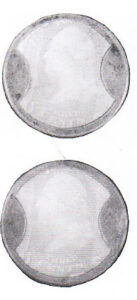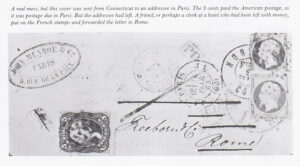


The five-cent stamp comes in three shades, buff or olive brown (#67), red brown (#75), and brown (#76). The rarest of the three is the buff: it was printed on a very thin, brittle paper, which tends to crack almost spontaneously, making sound examples of this stamp quite rare. The postal authorities did not care for the color, which was deemed too light in shade and some thought it could be confused with the three cent. Late in 1861, only a short time after issue, it was replaced with the red brown. Of the buff 175,000 were issued, although probably just a few thousand still exist. The red brown (#75) and the brown (#76) are not scarce stamps: between the two, about 7.5 million were issued, 1 million of the #75 and 6.5 million of the #76. The red brown (#75) is a particularly delicious shade, and should not be confused with the ordinary shoe-polish brown of #76.
The ten-cent stamp issued in 1861 comes in two types. Type I has no line above “U.S. POSTAGE” while Type II does, although most experts use this telltale characteristic only as a second check. The Type I (#62B) is in a deep oak-leaf green shade that, with experience, proclaims its rare status. One half million #62B stamps were issued, though the stamp seems far scarcer than that. The regular type II #68 is usually in a far lighter shade of green. Quantities issued of #68 are estimated at over 27 million, so this is not at all a rare stamp.

Japan was opened to Western commerce in the mid-1850s, but the Japanese Postal System proved quite unable to handle trans-oceanic mail, as the island nation was just emerging from feudalism and had no merchant shipping to speak of. So the United States opened a post office in Japan. The #68, the ten cent Type II green, is the first stamp known to have been used from Japan, usually cancelled “Hiogo.” Japanese Post Office cancellations are somewhat more common on the American 1867 and 1869 issues, reflecting increased trade between the two countries.
